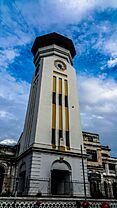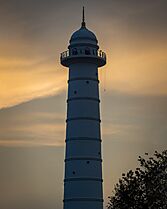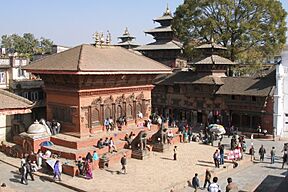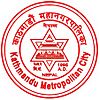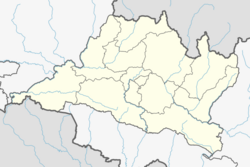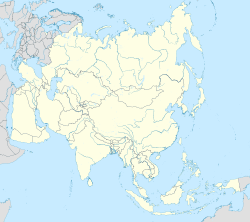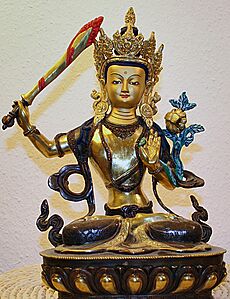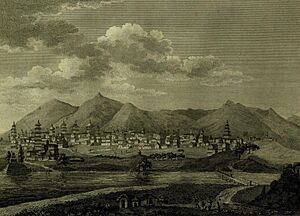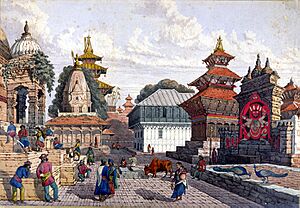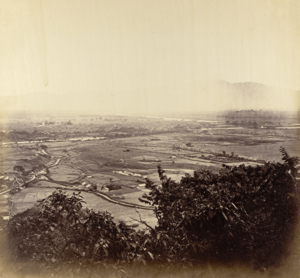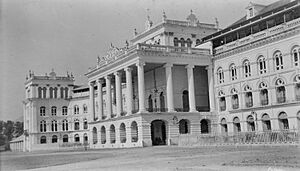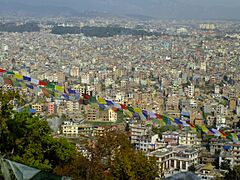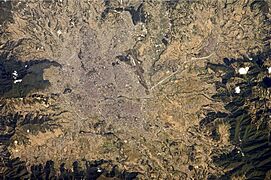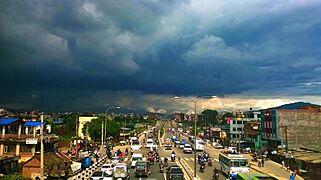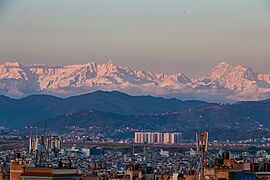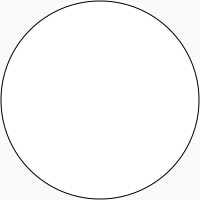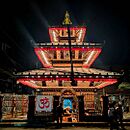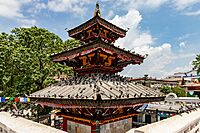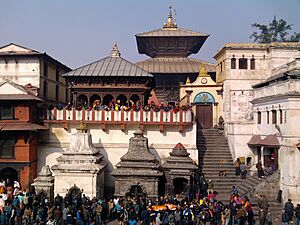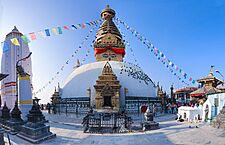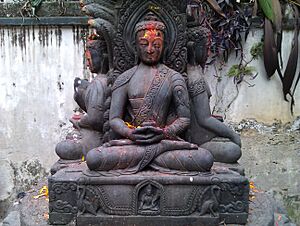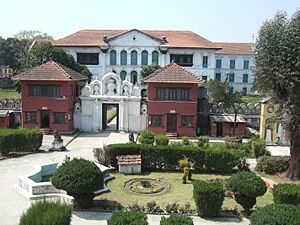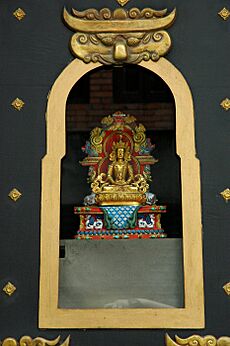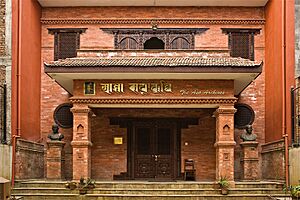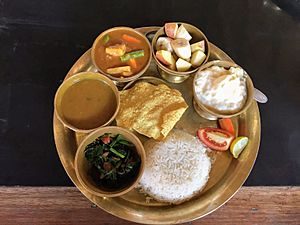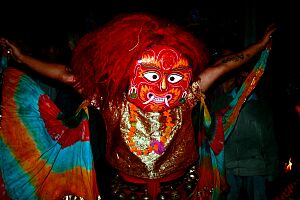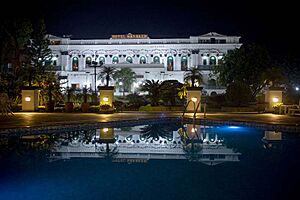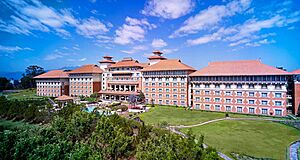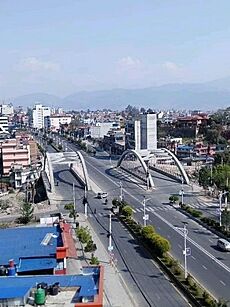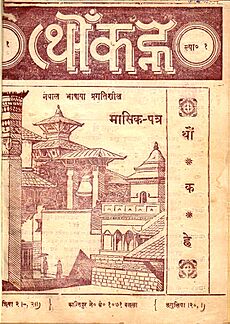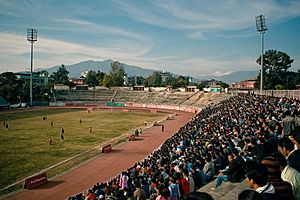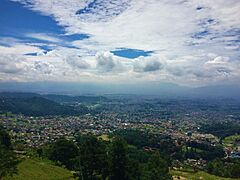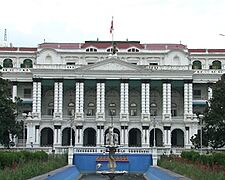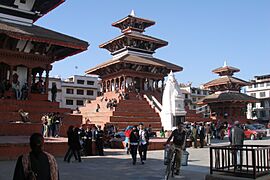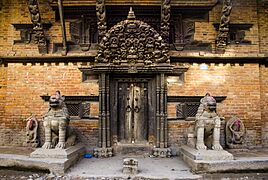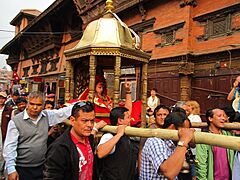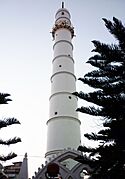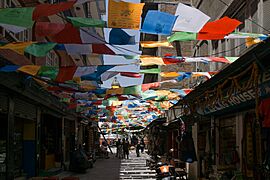Kathmandu facts for kids
Quick facts for kids
Kathmandu
काठमाडौँ
Kasthamandaw, Kantipur, Yen
|
|||
|---|---|---|---|
| Kathmandu Metropolitan City | |||
|
Kathmandu Skyline with Gaurishankar visible
Ghanta Ghar
Kathmandu Durbar Square
|
|||
|
|||
| Nickname(s):
City of Temples
|
|||
| Motto(s): | |||
| Country | |||
| Province | Bagmati | ||
| District | Kathmandu | ||
| Founded by | Manjushri | ||
| Named for | Kasthamandap | ||
| No. of Wards | 32 | ||
| Government | |||
| • Type | Mayor–council government | ||
| • Body | Kathmandu Metropolitan Government | ||
| Area | |||
| • Capital city | 49.45 km2 (19.09 sq mi) | ||
| • Metro | 899 km2 (347 sq mi) | ||
| Elevation | 1,400 m (4,600 ft) | ||
| Population
(2021)
|
|||
| • Capital city | 856,767 | ||
| • Rank | 1st | ||
| • Density | 17,103/km2 (44,300/sq mi) | ||
| • Metro | Approximately 4 million | ||
| • Metro rank | 1st | ||
| Time zone | UTC+05:45 (Nepal Standard Time) | ||
| Postal Code |
44600
|
||
| Area code(s) | 01 | ||
Kathmandu, officially Kathmandu Metropolitan City, is the capital and most populous city of Nepal with 845,767 inhabitants living in 105,649 households as of the 2021 Nepal census and approximately 4 million people in its urban agglomeration. It is located in the Kathmandu Valley, a large valley in the high plateaus in central Nepal, at an altitude of 1,400 metres (4,600 feet).
The city is one of the oldest continuously inhabited places in the world, founded in the 2nd century AD. The valley was historically called the "Nepal Mandala" and has been the home of the Newar people, a cosmopolitan urban civilization in the Himalayan foothills. The city was the royal capital of the Kingdom of Nepal and hosts palaces, mansions and gardens built by the Nepali aristocracy. It has been home to the headquarters of the South Asian Association for Regional Cooperation (SAARC) since 1985. Today, it is the seat of government of the Federal Democratic Republic of Nepal, established in 2008, and is part of Bagmati Province.
Kathmandu is and has been for many years the centre of Nepal's history, art, culture, and economy. It has a multi-ethnic population within a Hindu and Buddhist majority. Religious and cultural festivities form a major part of the lives of people residing in Kathmandu. Tourism is an important part of the economy in the city. In 2013, Kathmandu was ranked third among the top ten upcoming travel destinations in the world by TripAdvisor, and ranked first in Asia. The city is considered the gateway to the Nepal Himalayas and is home to several World Heritage Sites: the Durbar Square, Swayambhu Mahachaitya, Bouddha and Pashupatinath. Kathmandu valley is growing at 4 per cent per year according to the World Bank in 2010, making it one of the fastest-growing metropolitan areas in South Asia, and the first region in Nepal to face the unprecedented challenges of rapid urbanization and modernization at a metropolitan scale. It is the largest metropolitan area located in the Himalayas.
Contents
History
Archaeological excavations in parts of Kathmandu have found evidence of ancient civilizations. The oldest of these findings is a statue, found in Maligaon, that was dated at 185 AD. The excavation of Dhando Chaitya uncovered a brick with an inscription in Brahmi script. Archaeologists believe that it is two thousand years old. Stone inscriptions are ubiquitous elements at the heritage sites and are key sources for the history of Nepal.
The earliest Western reference to Kathmandu appears in an account of Portuguese Jesuit Father Joao Cabral who passed through the Kathmandu Valley in the spring of 1628 and was received graciously by the king of that time, probably King Lakshminarasimha Malla of Kathmandu on their way from Tibet to India. Father Cabral reported that they reached "Cadmendu", the capital of Nepal kingdom.'
Ancient history
The ancient history of Kathmandu is described in its traditional myths and legends. According to the Swayambhu Purana, present-day Kathmandu was once a huge and deep lake named "Nagdaha", as it was full of snakes. The lake was cut drained by Bodhisattva Manjushri with his sword, and the water was evacuated out from there. He then established a city called Manjupattan, and made Dharmakar the ruler of the valley land. After some time, a demon named Banasura closed the outlet, and the valley again turned into a lake. Krishna came to Nepal, killed Banasura, and again drained out the water by cutting the edge of Chobhar hill with this Sudarshana Chakra. He brought some cowherds along with him and made Bhuktaman the king of Nepal.
Kotirudra Samhita of Shiva Purana, Chapter 11, Shloka 18 refers to the place as Nayapala city, which was famous for its Pashupati Shivalinga. The name Nepal probably originates from this city Nayapala.
Very few historical records exists of the period before medieval Licchavi rulers. According to Gopalraj Vansawali, a genealogy of Nepali monarchy, the rulers of Kathmandu Valley before the Licchavis were Gopalas, Mahispalas, Aabhirs, Kiratas, and Somavanshi. The Kirata dynasty was established by Yalamber. During the Kirata era, a settlement called Yambu existed in the northern half of old Kathmandu. In some of the Sino-Tibetan languages, Kathmandu is still called Yambu. Another smaller settlement called Yengal was present in the southern half of old Kathmandu, near Manjupattan. During the reign of the seventh Kirata ruler, Jitedasti, Buddhist monks entered Kathmandu valley and established a forest monastery at Sankhu.
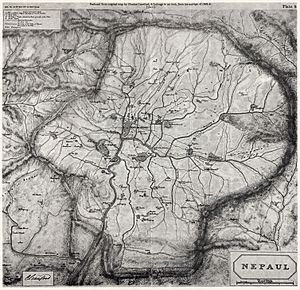
Licchavi era
The Licchavis from the Indo-Gangetic plain migrated north and defeated the Kirats, establishing the Licchavi dynasty, circa 400 AD. During this era, following the genocide of Shakyas in Lumbini by Virudhaka, the survivors migrated north and entered the forest monastery lora masquerading as Koliyas. From Sankhu, they migrated to Yambu and Yengal (Lanjagwal and Manjupattan) and established the first permanent Buddhist monasteries of Kathmandu. This created the basis of Newar Buddhism, which is the only surviving Sanskrit-based Buddhist tradition in the world. With their migration, Yambu was called Koligram and Yengal was called Dakshin Koligram during most of the Licchavi era.
Eventually, the Licchavi ruler Gunakamadeva merged Koligram and Dakshin Koligram, founding the city of Kathmandu. The city was designed in the shape of Chandrahrasa, the sword of Manjushri. The city was surrounded by eight barracks guarded by Ajimas. One of these barracks is still in use at Bhadrakali (in front of Singha Durbar). The city served as an important transit point in the trade between India and Tibet, leading to tremendous growth in architecture. Descriptions of buildings such as Managriha, Kailaskut Bhawan, and Bhadradiwas Bhawan have been found in the surviving journals of travellers and monks who lived during this era. For example, the famous 7th-century Chinese traveller Xuanzang described Kailaskut Bhawan, the palace of the Licchavi king Amshuverma. The trade route also led to cultural exchange as well. The artistry of the Newar people—the indigenous inhabitants of the Kathmandu Valley—became highly sought after during this era, both within the Valley and throughout the greater Himalayas. Newar artists travelled extensively throughout Asia, creating religious art for their neighbours. For example, Araniko led a group of his compatriot artists through Tibet and China. Bhrikuti, the princess of Nepal who married Tibetan monarch Songtsän Gampo, was instrumental in introducing Buddhism to Tibet.
Malla era
The Licchavi era was followed by the Malla era. Rulers from Tirhut, upon being attacked by the Delhi Sultanate, fled north to the Kathmandu valley. They intermarried with Nepali royalty, and this led to the Malla era. The early years of the Malla era were turbulent, with raids and attacks from Khas and Turk Muslims. There was also a devastating earthquake which claimed the lives of a third of Kathmandu's population, including the king Abhaya Malla. These disasters led to the destruction of most of the architecture of the Licchavi era (such as Mangriha and Kailashkut Bhawan), and the loss of literature collected in various monasteries within the city. Despite the initial hardships, Kathmandu rose to prominence again and, during most of the Malla era, dominated the trade between India and Tibet. Nepali currency became the standard currency in trans-Himalayan trade.
During the later part of the Malla era, Kathmandu Valley comprised four fortified cities: Kantipur, Lalitpur, Bhaktapur, and Kirtipur. These served as the capitals of the Malla confederation of Nepal. These states competed with each other in the arts, architecture, esthetics, and trade, resulting in tremendous development. The kings of this period directly influenced or involved themselves in the construction of public buildings, squares, and temples, as well as the development of waterspouts, the institutionalisation of trusts (called guthis), the codification of laws, the writing of dramas, and the performance of plays in city squares. Evidence of an influx of ideas from India, Tibet, China, Persia, and Europe among other places can be found in a stone inscription from the time of king Pratap Malla. Books have been found from this era that describe their tantric tradition (e.g. Tantrakhyan), medicine (e.g. Haramekhala), religion (e.g. Mooldevshashidev), law, morals, and history. Amarkosh, a Sanskrit-Nepal Bhasa dictionary from 1381, was also found. Architecturally notable buildings from this era include Kathmandu Durbar Square, Patan Durbar Square, Bhaktapur Durbar Square, the former durbar of Kirtipur, Nyatapola, Kumbheshwar, the Krishna temple, and others.
Medieval era
Early Shah rule
The Gorkha Kingdom ended the Malla confederation after the Battle of Kathmandu in 1768. This marked the beginning of the modern era in Kathmandu. The Battle of Kirtipur was the start of the Gorkha conquest of the Kathmandu Valley. Kathmandu was adopted as the capital of the Gorkha empire, and the empire itself was dubbed Nepal. During the early part of this era, Kathmandu maintained its distinctive culture. Buildings with characteristic Nepali architecture, such as the nine-story tower of Basantapur, were built during this era. However, trade declined because of continual war with neighbouring nations. Bhimsen Thapa supported France against Great Britain; this led to the development of modern military structures, such as modern barracks in Kathmandu. The nine-storey tower Dharahara was originally built during this era.
Rana rule
Rana rule over Nepal started with the Kot massacre of 1846, which occurred near Hanuman Dhoka Durbar. During this massacre, most of Nepal's high-ranking officials were massacred by Jung Bahadur Rana and his supporters. Another massacre, the Bhandarkhal Massacre, was also conducted by Kunwar and his supporters in Kathmandu. During the Rana regime, Kathmandu's alliance shifted from anti-British to pro-British; this led to the construction of the first buildings in the style of Western European architecture. The most well-known of these buildings include Singha Durbar, Garden of Dreams, Shital Niwas, and the old Narayanhiti palace. The first modern commercial road in the Kathmandu Valley, the New Road, was also built during this era. Trichandra College (the first college of Nepal), Durbar High School (the first modern school of Nepal), and Bir Hospital (the first hospital of Nepal) were built in Kathmandu during this era. Education was only accessible to the privileged class. Rana rule was marked by despotism, economic exploitation and religious persecution.
Geography
Kathmandu is in the northwestern part of the Kathmandu Valley to the north of the Bagmati River and covers an area of 50.7 km2 (19.6 sq mi). The average elevation is 1,400 metres (4,600 ft) above sea level. The city is bounded by several other municipalities of the Kathmandu valley: south of the Bagmati by Lalitpur Metropolitan City (Patan), with which it forms one urban area surrounded by a ring road, to the southwest by Kirtipur and to the east by Madyapur Thimi. To the north the urban area extends into several municipalities; Nagarjun, Tarakeshwor, Tokha, Budhanilkantha, Gokarneshwor and Kageshwori Manohara. However, the urban agglomeration extends well beyond the neighbouring municipalities, e.g. to Bhaktapur, and nearly covers the entire Kathmandu Valley.
 |
Tarakeshwor | Tokha / Budhanilkantha | Gokarneshwor |  |
| Nagarjun | Kageshwari Manohara | |||
| Kirtipur | Bagmati river Lalitpur |
Madhyapur Thimi |
Kathmandu is dissected by eight rivers, the main river of the valley, the Bagmati and its tributaries, of which the Bishnumati, Dhobi Khola, Manohara Khola, Hanumante Khola, and Tukucha Khola are predominant. The mountains from where these rivers originate are in the elevation range of 1,500–3,000 metres (4,900–9,800 ft), and have passes which provide access to and from Kathmandu and its valley. An ancient canal once flowed from Nagarjuna hill through Balaju to Kathmandu; this canal is now extinct.
The city of Kathmandu and the surrounding valley are in the Deciduous Monsoon Forest Zone (altitude range of 1,200–2,100 metres (3,900–6,900 ft)), one of five vegetation zones defined for Nepal. The dominant tree species in this zone are oak, elm, beech, maple and others, with coniferous trees at higher altitude.
Climate
| Weather chart for Kathmandu | |||||||||||||||||||||||||||||||||||||||||||||||
|---|---|---|---|---|---|---|---|---|---|---|---|---|---|---|---|---|---|---|---|---|---|---|---|---|---|---|---|---|---|---|---|---|---|---|---|---|---|---|---|---|---|---|---|---|---|---|---|
| J | F | M | A | M | J | J | A | S | O | N | D | ||||||||||||||||||||||||||||||||||||
|
14
19
2
|
19
21
5
|
34
25
8
|
61
28
12
|
124
29
16
|
236
29
19
|
363
28
20
|
331
29
20
|
200
28
19
|
51
27
13
|
8.3
24
8
|
13
20
4
|
||||||||||||||||||||||||||||||||||||
| temperatures in °C precipitation totals in mm |
|||||||||||||||||||||||||||||||||||||||||||||||
|
Imperial conversion
|
|||||||||||||||||||||||||||||||||||||||||||||||
Under Köppen's climate classification, portions of the city with lower elevations (1300-1400m) which is 88 per cent of total have a humid subtropical climate (Cwa), while portions of the city with higher elevations generally have a subtropical highland climate (Cwb). In the Kathmandu Valley, which is representative of its valley's climate, the average summer temperature varies from 28 to 30 °C (82 to 86 °F). The average winter temperature is 10.1 °C (50.2 °F). Five major climatic regions are found in Nepal. Of these, High hills of Kathmandu Valley including Chandragiri hill is in the Warm Temperate Zone (elevation ranging from 1,200 to 2,300 metres (3,900 to 7,500 ft)), where the climate is fairly temperate, atypical for the region. This zone is followed by the Cool Temperate Zone with elevation varying between 2,100 and 3,300 metres (6,900 and 10,800 ft).
The city generally has a climate with warm days followed by cool nights and mornings. Unpredictable weather is expected, given that temperatures can drop to 0 °C (32 °F) or less during the winter. The lowest ever temperature of -3.5 °C was recorded in 1978. While snowfall is generally confined to the hills surrounding the city, there have been a few instances of snowfall in city, most notably in 1945 and 2007.
Rainfall is mostly monsoon-based (about 65% of the total concentrated during the monsoon months of June to September), and decreases substantially (100 to 200 cm (39 to 79 in)) from eastern Nepal to western Nepal. The average annual rainfall for the city is around 1400 mm (55 in). On average humidity is 75%. The chart below is based on data from the Nepal Bureau of Standards & Meteorology, Weather Meteorology for 2005. The chart provides minimum and maximum temperatures during each month. The annual amount of precipitation was 1,124 millimetres (44.3 in) for 2005, as per monthly data included in the table above. The decade of 2000–2010 saw highly variable and unprecedented precipitation anomalies in Kathmandu. This was mostly due to the annual variation of the southwest monsoon. For example, 2001 recorded only 356 mm (14 in) of precipitation due to an extraordinarily weak monsoon season. In contrast, 2003 was the wettest year ever in Kathmandu, totaling over 2,900 mm (114 in) of precipitation due to an exceptionally strong monsoon season.
| Climate data for Kathmandu (1991–2020 normals, extremes 1968–2020) | |||||||||||||
|---|---|---|---|---|---|---|---|---|---|---|---|---|---|
| Month | Jan | Feb | Mar | Apr | May | Jun | Jul | Aug | Sep | Oct | Nov | Dec | Year |
| Record high °C (°F) | 27.4 (81.3) |
29.2 (84.6) |
31.6 (88.9) |
35.6 (96.1) |
36.6 (97.9) |
35.2 (95.4) |
34.6 (94.3) |
32.6 (90.7) |
32.3 (90.1) |
31.9 (89.4) |
30.0 (86.0) |
25.2 (77.4) |
36.6 (97.9) |
| Average high °C (°F) | 19.2 (66.6) |
22.1 (71.8) |
26.0 (78.8) |
28.6 (83.5) |
29.2 (84.6) |
29.5 (85.1) |
28.7 (83.7) |
29.0 (84.2) |
28.6 (83.5) |
27.2 (81.0) |
23.6 (74.5) |
20.2 (68.4) |
26.0 (78.8) |
| Daily mean °C (°F) | 11.0 (51.8) |
13.7 (56.7) |
17.4 (63.3) |
20.5 (68.9) |
22.7 (72.9) |
24.4 (75.9) |
24.5 (76.1) |
24.6 (76.3) |
23.7 (74.7) |
20.6 (69.1) |
16.0 (60.8) |
12.2 (54.0) |
19.3 (66.7) |
| Average low °C (°F) | 2.8 (37.0) |
5.3 (41.5) |
8.8 (47.8) |
12.3 (54.1) |
16.1 (61.0) |
19.3 (66.7) |
20.3 (68.5) |
20.2 (68.4) |
18.8 (65.8) |
13.9 (57.0) |
8.4 (47.1) |
4.2 (39.6) |
12.5 (54.5) |
| Record low °C (°F) | −3.5 (25.7) |
−2.4 (27.7) |
0.5 (32.9) |
3.5 (38.3) |
8.7 (47.7) |
11.1 (52.0) |
13.1 (55.6) |
13.0 (55.4) |
11.8 (53.2) |
5.8 (42.4) |
1.3 (34.3) |
−1.9 (28.6) |
−3.5 (25.7) |
| Average precipitation mm (inches) | 15.2 (0.60) |
23.6 (0.93) |
38.0 (1.50) |
63.1 (2.48) |
128.9 (5.07) |
242.0 (9.53) |
383.8 (15.11) |
342.7 (13.49) |
207.8 (8.18) |
43.3 (1.70) |
6.4 (0.25) |
7.8 (0.31) |
1,502.6 (59.16) |
| Average precipitation days (≥ 1.0 mm) | 1.9 | 2.6 | 3.9 | 6.6 | 11.9 | 16.9 | 23.1 | 22.7 | 14.6 | 3.8 | 0.5 | 0.7 | 109.4 |
| Average relative humidity (%) | 79 | 71 | 61 | 53 | 57 | 73 | 81 | 83 | 82 | 79 | 85 | 80 | 74 |
| Mean monthly sunshine hours | 210 | 209 | 236 | 230 | 244 | 175 | 130 | 160 | 156 | 233 | 228 | 211 | 2,422 |
| Source 1: World Meteorological Organization | |||||||||||||
| Source 2: Department of Hydrology and Meteorology, Deutscher Wetterdienst (sun, 1961–1990) | |||||||||||||
Air quality
Air pollution is a major issue in the Kathmandu Valley. According to the 2016 World Health Organization's Ambient Air Pollution Database, the annual average PM2.5 (particulate matter) concentration in 2013 was 49 μg/m3, which is 4.9 times higher than recommended by the World Health Organization. Starting in early 2017, the Government of Nepal and the Embassy of the United States in Kathmandu have monitored and publicly share real-time air quality data. In Nepal and Kathmandu, the annual premature deaths due to air pollution reached 37,399 and 9,943 respectively, according to a Republica news report published on 23 November 2019. This indicates, around a quarter of the total deaths due to air pollution in Nepal are in Kathmandu.
Demographics
Kathmandu's urban cosmopolitan character has made it the most populous city in Nepal. According to the National Population Census of 2011, the total population of Kathmandu city was 975,543 in 254,292 households with an annual growth rate of 6.12% with respect to the population figure of 2001. 70% of the total population residing in Kathmandu are aged between 15 and 59.
In one decade, the population increased from 427,045 in 1991 to 671,805 in 2001. The population was projected to reach 915,071 in 2011 and 1,319,597 by 2021. To keep up this population growth, the KMC-controlled area of 5,076.6 hectares (12,545 acres) expanded to 8,214 hectares (20,300 acres) in 2001. With this new area, the population density which was 85 in 1991 remained 85 in 2001; it is likely to jump to 111 in 2011 and 161 in 2021.
Languages
Nepali (62%) Newari (19%) Tamang (6%) Maithili (3%) Gurung (2%) Magar (2%) Others (6%)
As of the 2011 census, Nepali is the most common mother tongue in Kathmandu, with 62% of the population speaking it as their mother tongue. Newari is spoken by 19%, and the other languages spoken in the city include Tamang (6%), Maithili (3%), Bhojpuri (2%), Gurung (2%), Magar (2%) and Sherpa (1%) as their first language. English is also spoken by many.
Ethnic groups
Ethnic groups in Kathmandu Newar (24.7%) Hill Brahman (24.5%) Chhetri (18%) Tamang (7.8%) Magar (3.8%) Others (21.2%)
The largest group is the native Newars, whose various sub-groups combine to make up 24.7% of the population. Almost equal in number is the Bahuns, also known as Hill-Brahmin or Khas Brahmin, representing 24.5% of the population. They are part of the broader Khas community, as are the Chhetri, the third largest group, who account for 18% of the population. Other groups in Kathmandu include the Janajatis, comprising the Tamang (7.8%), Magar (3.8%), Gurung (2.6%), and Rai (2.1%). Nepalese Muslims represent 1.8% of the population. More recently, other Madeshi groups from Terai have come to represent a substantial proportion of the city's population, and there are around 12,000 Marwadis, mainly merchants.
| Broad Ethnic Category | Sub Category | Linguistic Family | Population Percentage |
|---|---|---|---|
| Khas Aryan (Hill/Pahari Caste Groups) | Khas Brahmin, Chhetri, Kami, Thakuri, Damai Sarki, Sanyasi/Dasnami | Indo-Aryan | 46.3% |
| Newar (Kathmandu Valley Caste Groups) | Newari Brahmin, Shrestha, Tamrakar, Dangol, Maharjan, Rajkarnikar, etc. | Sino-Tibetan | 24.7% |
| Janajati (Hill Tribal Groups) | Magar, Tamang, Gurung, Sherpa, Rai, Limbu, etc. | Sino-Tibetan | 19.2% |
| Madeshi (Terai Caste Groups) | Yadav, Maithil Brahmins, Chamar, Kushwaha, Musahar, Kurmi, Dhanuk, etc. | Indo-Aryan | 4.1% |
| Muslim | - | Indo-Aryan | 1.8% |
| Marwadi, Rajbanshi | - | Indo-Aryan | 1.6% |
| Adibasi (Terai Indigenous Groups) | Tharu, Rajbanshi, Tajpuriya, Santhal etc. | Indo-Aryan And Sino-Tibetan | 1.5% |
| Others | - | Indo-Aryan and Sino-Tibetan | 1.5% |
Architecture and cityscape
The ancient trade route between India and Tibet that passed through Kathmandu enabled a fusion of artistic and architectural traditions from other cultures to be amalgamated with local art and architecture. The monuments of Kathmandu City have been influenced over the centuries by Hindu and Buddhist religious practices. The architectural treasure of the Kathmandu valley has been categorized under the well-known seven groups of heritage monuments and buildings. In 2006 UNESCO declared these seven groups of monuments as a World Heritage Site (WHS). The seven monuments zones cover an area of 189 hectares (470 acres), with the buffer zone extending to 2,394 hectares (5,920 acres). The Seven Monument Zones inscribed originally in 1979 and with a minor modification in 2006 are the Durbar squares of Hanuman Dhoka, Patan and Bhaktapur, the Hindu temples of Pashupatinath and Changunarayan, the Buddhist stupas of Swayambhunath and Boudhanath.
Durbar Squares
The literal meaning of Durbar Square is a "place of palaces". There are three preserved Durbar Squares in Kathmandu valley and one unpreserved in Kirtipur. The Durbar Square of Kathmandu is in the old city and has heritage buildings representing four kingdoms (Kantipur, Lalitpur, Bhaktapur, Kirtipur); the earliest being the Licchavi dynasty. The complex has 50 temples and is distributed in two quadrangles of the Durbar Square. The outer quadrangle has the Kasthamandap, Kumari Ghar, and Shiva-Parvati Temple; the inner quadrangle has the Hanuman Dhoka palace. The squares were severely damaged in the April 2015 earthquake.
Hanuman Dhoka is a complex of structures with the royal palace of the Malla kings and of the Shah dynasty. It is spread over five acres. The eastern wing, with ten courtyards, is the oldest part, dating to the mid-16th century. It was expanded by King Pratap Malla in the 17th century with many temples. The royal family lived in this palace until 1886 when they moved to Narayanhiti Palace. The stone inscription outside is in fifteen languages.
Kumari Ghar is a palace in the centre of the Kathmandu city, next to the Durbar square where a royal Kumari selected from several Kumaris resides.
Kasthamandap is a three-storeyed temple enshrining an image of Gorakhnath. It was built in the 16th century in pagoda style. The name of Kathmandu is a derivative of the word Kasthamandap. It was built under the reign of King Laxmi Narsingha Malla. Kasthamandap stands at the intersection of two ancient trade routes linking India and Tibet at Maru square. It was originally built as a rest house for travellers.
Pashupatinath temple
The Pashupatinath Temple (Nepali: पशुपतिनाथ मन्दिर) is a famous 5th century Hindu temple dedicated to Shiva. Located on the banks of the Bagmati River, the Pashupatinath Temple is the oldest Hindu temple in Kathmandu. It served as the seat of national deity, Pashupatinath, until Nepal was secularized. However, a significant part of the temple was destroyed by Mughal invaders in the 14th century and little or nothing remains of the original 5th-century temple exterior. The temple as it stands today was built in the 19th century, although the image of the bull and the black four-headed image of Pashupati are at least 300 years old. The temple is a UNESCO World Heritage Site. Shivaratri, or the night of Shiva, is the most important festival that takes place here, attracting thousands of devotees and sadhus.
Believers in Pashupatinath (mainly Hindus) are allowed to enter the temple premises, but non-Hindu visitors are allowed to view the temple only from the across the Bagmati River. The priests who perform the services at this temple have been Brahmins from Karnataka in southern India since the time of Malla king Yaksha Malla. This tradition is believed to have been started at the request of Adi Shankara who sought to unify the states of Bhāratam, a region in south Asia believed to be ruled by a mythological king Bharata, by encouraging cultural exchange. This procedure is followed in other temples around India, which were sanctified by Adi Shankara.
The temple is built in the pagoda style of architecture, with cubic constructions and carved wooden rafters (tundal) on which they rest, and two-level roofs made of copper and gold.
Boudhanath
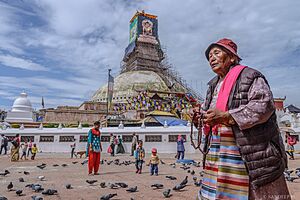
Boudhanath (Nepali: बौद्ध स्तुप; also written as Bouddhanath, Bodhnath, Baudhanath or the Khāsa Chaitya), is one of the holiest Buddhist sites in Nepal, along with the Swayambhunath. It is a very popular tourist site. Boudhanath is known as Khāsti by Newars and as Bauddha or Bodhnāth by speakers of Nepali. About 11 km (7 mi) from the centre and northeastern outskirts of Kathmandu, the stupa's massive mandala makes it one of the largest spherical stupas in Nepal. Boudhanath became a UNESCO World Heritage Site in 1979.
The base of the stupa has 108 small depictions of the Dhyani Buddha Amitabha. It is surrounded with a brick wall with 147 niches, each with four or five prayer wheels engraved with the mantra, Om mani padme hum. At the northern entrance where visitors must pass is a shrine dedicated to Ajima, the goddess of smallpox. Every year the stupa attracts many Tibetan Buddhist pilgrims who perform full body prostrations in the inner lower enclosure, walk around the stupa with prayer wheels, chant, and pray. Thousands of prayer flags are hoisted up from the top of the stupa downwards and dot the perimeter of the complex. The influx of many Tibetan refugees from China has seen the construction of over 50 Tibetan gompas (monasteries) around Boudhanath.
Swayambhu
Swayambhunath (Nepali: स्वयम्भू स्तूप) is a Buddhist stupa atop a hillock at the northwestern part of the city. This is among the oldest religious sites in Nepal. Although the site is considered Buddhist, it is revered by both Buddhists and Hindus. The stupa consists of a dome at the base; above the dome, there is a cubic structure with the eyes of Buddha looking in all four directions. There are pentagonal toran above each of the four sides, with statues engraved on them. Behind and above the torana there are thirteen tiers. Above all the tiers, there is a small space above which lies a gajur.
Rani Pokhari
Ranipokhari (Nepali: रानी पोखरी, lit. 'Queen's Pond') is a historic artificial pond nestled in the heart of Kathmandu. It was built by king Pratap Malla in 1670 for his beloved queen after she lost her son and could not recover from her loss. A large stone statue of an elephant in the south signifies the image of Pratap Malla and his two sons. Balgopaleshwor Temple stands still inside the temple above the pond. Rani Pokhari is opened once a year during the final day of Tihar i.e. Bhai Tika and Chhath festival. The world's largest Chhath takes place every year in Ranipokhari. The pond is one of Kathmandu's most famous landmarks and is known for its religious and aesthetic significance. However, Ranipokhari is now under development, which began in 2019 and is expected to be finished next year, according to reports.
Culture
Arts
Kathmandu valley the City of Newars is described as "an enormous treasure house of art and sculptures", which are made of wood, stone, metal, and terracotta, and found in profusion in temples, shrines, stupas, gompas, chaityas and palaces. The art objects are also seen in street corners, lanes, private courtyards and in open ground. Most art is in the form of icons of gods and goddesses. Kathmandu valley has had this art treasure for a very long time, but received worldwide recognition only after the country opened to the outside world in 1950.
The religious art of Nepal and Kathmandu in particular consists of an iconic symbolism of the Mother Goddesses such as: Bhavani, Durga, Gaja-Lakshmi, Hariti-Sitala, Mahsishamardini, Saptamatrika (seven mother goddesses), and Sri-Lakshmi (wealth-goddess). From the 3rd century BCE, apart from the Hindu gods and goddesses, Buddhist monuments from the Ashokan period (it is said that Ashoka visited Nepal in 250 BC) have embellished Nepal in general and the valley in particular. These art and architectural edifices encompass three major periods of evolution: the Licchavi or classical period (500 to 900 AD), the post-classical period (1000 to 1400 AD), with strong influence of the Palla art form; the Malla period (1400 onwards) that exhibited explicitly tantric influences coupled with the art of Tibetan Demonology.
A broad typology has been ascribed to the decorative designs and carvings created by the people of Nepal. These artists have maintained a blend of Hinduism and Buddhism. The typology, based on the type of material used are: stone art, metal art, wood art, terracotta art, and painting.
Museums
Kathmandu is home to a number of museums and art galleries, including the National Museum of Nepal and the Natural History Museum of Nepal. Nepal's art and architecture is an amalgamation of two ancient religions, Hinduism and Buddhism. These are amply reflected in the many temples, shrines, stupas, monasteries, and palaces in the seven well-defined Monument Zones of the Kathmandu valley are part of a UNESCO World Heritage Site. This amalgamation is also reflected in the planning and exhibitions in museums and art galleries throughout Kathmandu and its sister cities of Patan and Bhaktapur. The museums display unique artefacts and paintings from the 5th century CE to the present day, including archaeological exportation.
Museums and art galleries in Kathmandu include:
- The National Museum
- The Natural History Museum
- Hanuman Dhoka Palace Complex
- The Kaiser Library
- The National Art Gallery
- The NEF-ART (Nepal Fine Art) Gallery
- The Nepal Art Council Gallery
- Narayanhiti Palace Museum
- The Taragaon Museum
The National Museum is in the western part of Kathmandu, near the Swayambhunath stupa in a historical building constructed in the early 19th century by General Bhimsen Thapa. It is the most important museum in the country, housing an extensive collection of weapons, art and antiquities of historic and cultural importance. The museum was established in 1928 as a collection house of war trophies and weapons, and the initial name of this museum was Chhauni Silkhana, meaning "the stone house of arms and ammunition". Given its focus, the museum contains many weapons, including locally made firearms used in wars, leather cannons from the 18th–19th century, and medieval and modern works in wood, bronze, stone and paintings.
The Natural History Museum is in the southern foothills of Swayambhunath hill and has a sizeable collection of different species of animals, butterflies, and plants. The museum is noted for its display of species, from prehistoric shells to stuffed animals.
The Tribhuvan Museum contains artifacts related to King Tribhuvan (1906–1955). It has a variety of pieces including his personal belongings, letters, and papers, memorabilia related to events he was involved in and a rare collection of photos and paintings of Royal family members. The Mahendra Museum is dedicated to the King Mahendra (1920–1972). Like the Tribhuvan Museum, it includes his personal belongings such as decorations, stamps, coins and personal notes and manuscripts, but it also has structural reconstructions of his cabinet room and office chamber. The Hanumandhoka Palace, a lavish medieval palace complex in the Durbar, contains three separate museums of historic importance. These museums include the Birendra museum, which contains items related to the second-last monarch, King Birendra.
The enclosed compound of the Narayanhiti Palace Museum is in the north-central part of Kathmandu. "Narayanhiti" (Nepali: नारायणहिटी) comes from Narayana (Nepali: नारायण), a form of the Hindu god Vishnu, and Hiti (Nepali: हिटी), meaning "water spout" (the temple of lord Vishnu is opposite to the palace, and the water spout is east of the main entrance to the precinct). The current palace building was built in 1970 in front of the old palace, built in 1915, in the form of a contemporary pagoda. It was built on the occasion of the marriage of the then crown prince and heir apparent to the throne, Birendra. The southern gate of the palace is at the crossing of Prithvipath and Durbar Marg roads. The palace area covers 30 hectares (74 acres) and is fully secured with gates on all sides. This palace was the scene of the Nepali royal massacre. After the fall of the monarchy, it has been converted into a museum.
The Taragaon Museum presents the modern history of the Kathmandu valley. It seeks to document 50 years of research and cultural heritage conservation of the Kathmandu Valley, documenting what artists, photographers, architects, and anthropologists from abroad had contributed in the second half of the 20th century. The actual structure of the museum showcases restoration and rehabilitation efforts to preserve the built heritage of Kathmandu. It was designed by Carl Pruscha (master-planner of the Kathmandu Valley) in 1970 and constructed in 1971. Restoration works began in 2010 to rehabilitate the Taragaon hostel into the Taragaon Museum. The design uses local brick along with modern architectural design elements, as well as the use of circle, triangles and squares. The museum is within a short walk from the Boudhanath stupa, which itself can be seen from the museum tower.
Art galleries
Kathmandu is a centre for art in Nepal, displaying the work of contemporary artists in the country and also collections of historical artists. Patan in particular is an ancient city noted for its fine arts and crafts. Art in Kathmandu is vibrant, demonstrating a fusion of traditionalism and modern art, derived from a great number of national, Asian, and global influences. Nepali art is commonly divided into two areas: the idealistic traditional painting known as Paubhas in Nepal and perhaps more commonly known as Thangkas in Tibet, closely linked to the country's religious history and on the other hand the contemporary western-style painting, including nature-based compositions or abstract artwork based on Tantric elements and social themes of which painters in Nepal are well noted for. Internationally, the British-based charity, the Kathmandu Contemporary Art Centre is involved with promoting arts in Kathmandu.
Kathmandu houses many notable art galleries. The NAFA Gallery, operated by the Arts and crafts Department of the Nepal Academy is housed in Sita Bhavan, a neo-classical old Rana palace.
The Srijana Contemporary Art Gallery, inside the Bhrikutimandap Exhibition grounds, hosts the work of contemporary painters and sculptors, and regularly organizes exhibitions. It also runs morning and evening classes in the schools of art. Also of note is the Moti Azima Gallery, in a three-storied building in Bhimsenthan which contains an impressive collection of traditional utensils and handmade dolls and items typical of a medieval Newar house, giving an important insight into Nepali history. The J Art Gallery near the former royal palace in Durbarmarg displays the artwork of eminent, established Nepali painters. The Nepal Art Council Gallery, in the Babar Mahal, on the way to Tribhuvan International Airport contains artwork of both national and international artists and extensive halls regularly used for art exhibitions.
Literature
The National Library of Nepal is located in Patan. It is the largest library in the country with more than 70,000 books in English, Nepali, Sanskrit, Hindi, and Nepal Bhasa. The library is in possession of rare scholarly books in Sanskrit and English dating from the 17th century. Kathmandu also contains the Kaiser Library, in the Kaiser Mahal on the ground floor of the Ministry of Education building. This collection of around 45,000 books is derived from a personal collection of Kaiser Shamsher Jang Bahadur Rana. It covers a wide range of subjects including history, law, art, religion, and philosophy, as well as a Sanskrit manual of Tantra, which is believed to be over 1,000 years old. The 2015 earthquake caused severe damage to the Ministry of Education building, and the contents of the Kaiser Library have been temporarily relocated.
The Asa Archives are also noteworthy. They specialize in medieval history and religious traditions of the Kathmandu valley. The archives, in Kulambhulu, have a collection of some 6,000 loose-leaf handwritten books and 1,000 palm-leaf manuscripts (mostly in Sanskrit or Nepal Bhasa) and a manuscript dated to 1464.
Cinema and theatre
Kathmandu is home to Nepali cinema and theatres. The city contains several theatres, including the National Dance Theatre in Kanti Path, the Ganga Theatre, the Himalayan Theatre and the Aarohan Theater Group founded in 1982. The M. Art Theater is based in the city. The Gurukul School of Theatre organizes the Kathmandu International Theater Festival, attracting artists from all over the world. A mini theatre has been opened at the Hanumandhoka Durbar Square, established by the Durbar Conservation and Promotion Committee.
Kathmandu has a number of cinemas (old single screen establishments and some new multiplexes) showing Nepali, Bollywood and Hollywood films. Some old establishments include Vishwajyoti Cinema Hall, Jai Nepal Hall, Kumari Cinema Hall, Gopi Krishna Cinema Hall and Guna Cinema Hall. Kathmandu also houses some international standard cinema theatres and multiplexes, such as QFX Cinemas, Cine De Chef, Fcube Cinemas, Q's Cinemas, Big Movies, BSR Movies and many more.
Music
Kathmandu is the center of music and dance in Nepal, and these art forms are integral to understanding the city. Musical performances are organized in cultural venues. Music is a part of the traditional aspect of Kathmandu. Gunla is the traditional music festival according to Nepal Sambat. Newar music originated in Kathmandu. Furthermore, music from all over Nepal can be found in Kathmandu.
A number of hippies visited Kathmandu during the 1970s and introduced rock music and jazz to the city. Kathmandu is noted internationally for its jazz festival, popularly known as Jazzmandu. It is the only jazz festival in the Himalayan region and was established in March 2002. The festival attracts musicians from countries worldwide, such as Australia, Denmark, United States, Benin, and India.
The city has been referenced in numerous songs, including works by Cat Stevens ('Katmandu', Mona Bone Jakon (1970), Bob Seger ('Katmandu', Beautiful Loser (1975)), Rush ('A Passage to Bangkok', Pulling into Kathmandu; 2112, 1976), John Lennon ('Nobody Told Me' (1984, posthumously)), Krematorij ('Kathmandu', Three Springs (2000)), Fito Páez (Tráfico por Katmandú – "Traffic through Kathmandu") and Cavalcade ('Kathmandu Kid') 2019.
Cuisine
The staple food of most people in Kathmandu is dal bhat. This consists of rice and lentil soup, generally served with vegetable curries, achar and sometimes chutney. Momo, a type of Nepali version of Tibetan dumpling, has become prominent in Nepal with many street vendors and restaurants selling it. It is one of the most popular fast foods in Kathmandu. Various Nepali variants of momo including buff (i.e. buffalo) dumplings, chicken dumplings, and vegetarian momo are famous in Kathmandu.
Most of the cuisines found in Kathmandu are non-vegetarian. However, the practice of vegetarianism is not uncommon, and vegetarian cuisines can be found throughout the city. Consumption of beef is very uncommon and considered taboo in many places. Buff (meat of water buffalo) is very common. There is a strong tradition of buff consumption in Kathmandu, especially among Newars, which is not found in other parts of Nepal. Consumption of pork was considered taboo until a few decades ago. Due to the intermixing with Kirat cuisine from eastern Nepal, pork has found a place in Kathmandu dishes. A fringe population of devout Hindus and Muslims consider it taboo. The Muslims forbid eating buff as from Quran while Hindus eat all varieties except beef as they consider cow to be a goddess and symbol of purity. The chief lunch/snack for locals and visitors is mostly Momo or Chowmein.
Kathmandu had only one western-style restaurant in 1955. A large number of restaurants in Kathmandu have since opened, catering Nepali cuisine, Tibetan cuisine, Chinese cuisine and Indian cuisine in particular. Many other restaurants have opened to accommodate locals, expatriates, and tourists. The growth of tourism in Kathmandu has led to culinary creativity and the development of hybrid foods to accommodate for tourists such as American chop suey, which is a sweet-and-sour sauce with crispy noodles with a fried egg commonly added on top and other westernized adaptations of traditional cuisine. Continental cuisine can be found in selected places. International chain restaurants are rare, but some outlets of Pizza Hut and KFC have recently opened there. It also has several outlets of the international ice-cream chain Baskin-Robbins.
Kathmandu has a larger proportion of tea drinkers than coffee drinkers. Tea, locally known as Chiya, is widely served but is extremely weak by western standards. It is richer and contains tea leaves boiled with milk, sugar, and spices. Tea shops that specially serve tea with other snacks are widely available.
Festivals
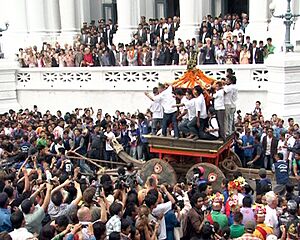
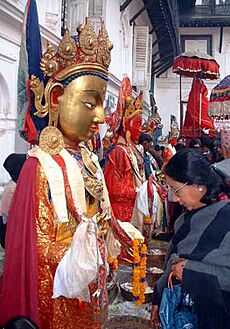
Most of the fairs and festivals in Kathmandu originated in the Malla period or earlier. Traditionally, these festivals were celebrated by Newars. In recent years, these festivals have found wider participation from other Kathmanduites as well. As the capital of the Nepal, various national festivals are celebrated in Kathmandu. With mass migration to the city, the cultures of Khas from the west, Kirats from the east, Bon/Tibetan from the north, and Mithila from the south meet in the capital and mingle harmoniously. The festivities such as the Ghode (horse) Jatra, Indra Jatra, Dashain Durga Puja festivals, Shivratri and many more are observed by all Hindu and Buddhist communities of Kathmandu with devotional fervor and enthusiasm. Social regulation in the codes enacted incorporates Hindu traditions and ethics. These were followed by the Shah kings and previous kings, as devout Hindus and protectors of the Buddhist religion.
Cultural continuity has been maintained for centuries in the exclusive worship of goddesses and deities in Kathmandu and the rest of the country. These deities include the Ajima, Taleju (or Tulja Bhavani or Taleju Bhawani) and her other form : Digu Taleju (or Degu Taleju) and Kumari (the living goddess). The artistic edifices have now become places of worship in the everyday life of the people, therefore a roster is maintained to observe annual festivals. There are 133 festivals held in the year.
Some of the traditional festivals observed in Kathmandu, apart from those previously mentioned, are Bada Dashain, Tihar, Chhath, Maghe Sankranti, Nag Panchami, Janai Purnima, Pancha Dan, Teej/Rishi Panchami, Pahan Charhe, Jana Baha Dyah Jatra (White Machchhendranath Jatra), and Matatirtha Aunsi.
Religions
Hinduism
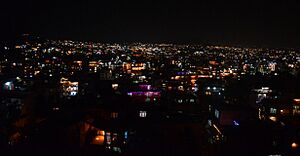
Hinduism is one of the indigenous beliefs of the city. Assumedly, together with the kingdom of Licchhavi (c. 400 to 750), Hinduism and the endogam social stratification of the caste was established in Kathmandu Valley. The Pashupatinath Temple, Changu Narayan Temple, and the Kasthamandap are of particular importance to Hindus. Other notable Hindu temples in Kathmandu and the surrounding valley include Bajrayogini Temple, Dakshinkali Temple, Guhyeshwari Temple, and the Shobha Bhagawati shrine.
The Bagmati River which flows through Kathmandu is considered a holy river both by Hindus and Buddhists, and many Hindu temples are on the banks of this river. The importance of the Bagmati also lies in the fact that Hindus are cremated on its banks, and Kirants are buried in the hills by its side. According to the Nepali Hindu tradition, the dead body must be dipped three times into the Bagmati before cremation. The chief mourner (usually the first son) who lights the funeral pyre must take a holy riverwater bath immediately after cremation. Many relatives who join the funeral procession also take bath in the Bagmati or sprinkle the holy water on their bodies at the end of cremation as the Bagmati is believed to purify people spiritually.
Buddhism
Buddhism was brought into Kathmandu with the arrival of Buddhist monks during the time of Buddha (c. 563 – 483 BCE). They established a forest monastery in Sankhu. This monastery was renovated by Shakyas after they fled genocide from Virudhaka (r. 491–461 BCE).
During the Hindu Lichchavi era (c. 400 to 750), various monasteries and orders were created which successively led to the formation of Newar Buddhism, which is still practiced in the primary liturgical language of Hinduism, Sanskrit.
Legendary Princess Bhrikuti (7th-century) and artist Araniko (1245–1306 CE) from that tradition of Kathmandu valley played a significant role in spreading Buddhism in Tibet and China. There are over 108 traditional monasteries (Bahals and Baháʼís) in Kathmandu based on Newar Buddhism. Since the 1960s, the permanent Tibetan Buddhist population of Kathmandu has risen significantly so that there are now over fifty Tibetan Buddhist monasteries in the area. Also, with the modernization of Newar Buddhism, various Theravada Bihars have been established.
Kirat Mundhum
Kirant Mundhum is one of the indigenous animistic practices of Nepal. It is practiced by the Kirat people. Some animistic aspects of Kirant beliefs, such as ancestor worship (worship of Ajima) are also found in Newars of Kirant origin. Ancient religious sites believed to be worshipped by ancient Kirats, such as Pashupatinath, Wanga Akash Bhairabh (Yalambar) and Ajima are now worshipped by people of all Dharmic religions in Kathmandu. Kirats who have migrated from other parts of Nepal to Kathmandu practice Mundhum in the city.
Other religions
Sikhism is practiced primarily in Gurudwara at Kupundole. An earlier temple of Sikhism is also present in Kathmandu which is now defunct.
Jainism is practiced by a small community. A Jain temple is present in Gyaneshwar, where Jains practice their faith.
According to the records of the Spiritual Assembly of the Baháʼís of Nepal, there are approximately 300 followers of the Baháʼí Faith in Kathmandu valley. They have a national office in Shantinagar, Baneshwor. The Baháʼís also have classes for children at the National Centre and other localities in Kathmandu.
In Kathmandu alone there are about 170 Christian churches. Christian missionary hospitals, welfare organizations, and schools are also operating. Nepali citizens who served as soldiers in Indian and British armies, who had converted to Christianity while in service, on return to Nepal continue to practice their religion. They have contributed to the spread of Christianity and the building of churches in Nepal and in Kathmandu, in particular.
Education
The oldest modern school in Nepal, the Durbar High School, and the oldest college, the Tri-Chandra College, are both in Kathmandu. The largest (according to number of students and colleges), the oldest and most distinguished university in Nepal, the Tribhuvan University, is located in Kirtipur.
The oldest engineering college in Nepal, Thapathali Campus also lies in Kathmandu. Not surprisingly the best schools and colleges of Nepal are located in Kathmandu and its adjoining cities. Every year thousands of students from all over Nepal arrive at Kathmandu to get admission in the various schools and colleges.
Tourism
Tourism is considered another important industry in Nepal. This industry started around 1950, as the country's political makeup changed and ended the country's isolation from the rest of the world. In 1956, air transportation was established and the Tribhuvan Highway, between Kathmandu and Raxaul (at India's border), was started. Separate organizations were created in Kathmandu to promote this activity; some of these include the Tourism Development Board, the Department of Tourism and the Civil Aviation Department. Furthermore, Nepal became a member of several international tourist associations. Establishing diplomatic relations with other nations further accentuated this activity. The hotel industry, travel agencies, training of tourist guides, and targeted publicity campaigns are the chief reasons for the remarkable growth of this industry in Nepal, and in Kathmandu in particular. Since then, tourism in Nepal has thrived. It is the country's most important industry. Tourism is a major source of income for most of the people in the city, with several hundred thousand visitors annually. Hindu and Buddhist pilgrims from all over the world visit Kathmandu's religious sites such as Pashupatinath, Swayambhunath, Boudhanath, Changunarayan and Budhanilkantha. From a mere 6,179 tourists in 1961/62, the number increased to 491,504 in 1999/2000. In economic terms, the foreign exchange registered 3.8% of the GDP in 1995/96 but then started declining. Following the end of the Maoist insurgency, there was a significant rise in the number of tourist arrivals, with 509,956 tourists recorded in 2009. Since then, tourism has improved as the country transitioned into a republic. The high level of tourism is attributed to the natural grandeur of the Himalayas and the rich cultural heritage of the country.
The neighbourhood of Thamel is Kathmandu's primary "traveller's ghetto", packed with guest houses, restaurants, shops, and bookstores, catering to tourists. Another neighbourhood of growing popularity is Jhamel, a name for Jhamsikhel that was coined to rhyme with Thamel. Jhochhen Tol, also known as Freak Street, is Kathmandu's original traveller's haunt, made popular by the hippies of the 1960s and 1970s; it remains a popular alternative to Thamel. Ason is a bazaar and ceremonial square on the old trade route to Tibet, and provides a fine example of a traditional neighbourhood.
With the opening of the tourist industry after the change in the political scenario of Nepal in 1950, the hotel industry drastically improved. Now Kathmandu boasts several luxuries such as the Hyatt Regency, Dwarika's, Hotel Yak & Yeti, The Everest Hotel, Hotel Radisson, Hotel De L'Annapurna, The Malla Hotel, Shangri-La Hotel (not operated by the Shangri-La Hotel Group) and Hotel Shanker. There are several four-star hotels such as Akama Hotel, Hotel Vaishali, Hotel Narayani, The Blue Star and Grand Hotel. The Garden Hotel, Hotel Ambassador, and Aloha Inn are among the three-star hotels in Kathmandu. Hotels like Hyatt Regency, De L'Annapurna, and Yak & Yeti are among the five-star hotels with casinos as well.
Transport
Road
The total length of roads in Nepal is recorded to be 17,182 km (10,676 mi), as of 2003–04. This fairly large network has helped the economic development of the country, particularly in the fields of agriculture, horticulture, vegetable farming, industry and also tourism. In view of the hilly terrain, transportation takes place in Kathmandu are mainly by road and air. Kathmandu is connected by the Tribhuvan Highway to the south connecting India, Prithvi Highway to the west and Araniko Highway to the north connecting China. The BP Highway connects Kathmandu to the eastern part of Nepal through Sindhuli. The fast-track is under construction which will be the shortest route to connect Terai with the valley.
Sajha Yatayat provides regular bus services throughout Kathmandu and the surrounding valley. Other bus companies including micro-bus companies operate several unscheduled routes. Trolleybusses used to operate on the route between Tripureshwor and Suryabinayak on a 13-kilometre route.
Air
The main international airport serving Kathmandu valley is the Tribhuvan International Airport, about 6 kilometres (3.7 mi) from the city centre and is operated by the Civil Aviation Authority of Nepal. It has two terminals, one domestic and one international. At present, it connects 30 cities around the globe in Europe, Asia and the Middle East such as Istanbul, Delhi, Mumbai, Bangalore, Kolkata, Singapore, Bangkok, Kuala Lumpur, Dhaka, Paro, Lhasa, Chengdu, Guangzhou and Hong Kong. Since 2013, Turkish Airlines has connected Istanbul to Kathmandu. Oman Air also connects Muscat to Kathmandu since 2010. Nepal Airlines started flying to Tokyo-Narita from 2 March 2020. Regionally, several Nepali airlines operate from the city, including Buddha Air, Nepal Airlines, Shree Airlines and Yeti Airlines to other major towns across Nepal.
Ropeways
Ropeways are another important transportation means in hilly terrain. A ropeway operated between Kathmandu and Hetauda over a length of 43 km (27 mi) which carried 25 tonnes of goods per hour. It has since been discontinued due to poor carrying capacity and maintenance issues. During the Rana period, a ropeway was constructed between Mathatirtha in Kathmandu to Dhorsing in Makawanpur of over 22 km (14 mi) in length, which carried a cargo of 8 tonnes per hour. At present, a cable car service is operated in Kathmandu in Chandragiri Hills.
Sports
Cricket and football are the most popular sports among the younger generation in Nepal and there are several stadiums in the city. The sport is governed by the National Sports Council from its headquarters in Kathmandu. The only international football stadium in the city is the Dasharath Rangasala, a multi-purpose stadium used mostly for football matches and cultural events, in the neighbourhood of Tripureshwor. It is the largest stadium in Nepal with a capacity of 25,000 spectators, built in 1956. Martyr's Memorial League is also held in this ground every year. The stadium was renovated with Chinese aid before the 8th South Asian Games were held in Kathmandu and floodlights were installed. Kathmandu is home to the oldest football clubs of Nepal such as Ranipokhari Corner Team (RCT), Sankata Club and New Road Team (NRT). Other prominent clubs include Manang Marsyangdi Club, Machhindra FC, Tribhuvan Army Club (TAC) and Nepal Police Club.
Kathmandu is also home of some of the oldest cricket clubs in Nepal, such as Yengal Sports Club. Kathmandu Kings XI represents Kathmandu in the Everest Premier League.
Twin towns – sister cities
Kathmandu is twinned with:
Proposed sister cities
 Bangkok, Thailand
Bangkok, Thailand
Notable people
- King Tribhuvan
- King Mahendra
- King Birendra
- Bhimsen Thapa, Prime Minister of Nepal
- Jung Bahadur Rana, Prime Minister of Nepal
- Rana Jang Pande, Prime Minister of Nepal
- Gehendra Sumsher Rana, first scientist of Nepal
- Laxmi Prasad Devkota, writer
- Martyrs of Nepal:
- Dharma Bhakta Mathema
- Gangalal Shrestha
- Madan Krishna Shrestha, actor and comedian
- Hari Bansha Acharya, actor and comedian
- Manisha Koirala, Bollywood actress
- Rajesh Hamal, actor
- Amrita Acharia, actress
- Curtis Waters, recording artist
- Anuradha Koirala, social activist
- Pushpa Basnet, social activist
- Pardeep Bastola, Nepali movie actor
- Baikuntha Manandhar, marathon runner
- Narendra Man Singh, football player
- Paras Khadka, cricketer
- Priti Rijal, professional tennis player
- Sushma Shakya, artist
- Gagan Thapa, politician
- Prakash Man Singh, politician
- Balendra Shah, rapper, civil engineer,
mayor-elect in 2022 - Nirmal Purja, Nims Dai, mountaineer - 14 peaks
- Asta Narayan Manandhar the first bicycle shop in Kathmandu in 1925
Gallery
-
Dharahara in 2014
-
Alleyway in Boudhanath
See also
 In Spanish: Katmandú para niños
In Spanish: Katmandú para niños



